Home / Reactions of Dienes: 1,2 and 1,4 Addition
Dienes and MO Theory
Reactions of Dienes: 1,2 and 1,4 Addition
Last updated: February 16th, 2025 |
Kinetic Versus Thermodynamic Control In Addition of HBr to Dienes: 1,2- and 1,4- Addition
In today’s post we’ll discuss 1,2- and 1,4- addition to dienes – specifically, the addition of strong acid such as HBr.
- When a diene undergoes reaction with a strong acid like HBr, protonation results in a resonance-stabilized carbocation
- The resonance-stabilized carbocation can undergo attack at two possible positions.
- When the reaction is conducted at low temperatures, the reaction is irreversible and the major product will be the one with the lowest-energy transition state, which is the carbon best able to stabilize positive charge.
- This is referred to as running the reaction under kinetic control.
- When the reaction is conducted at higher temperatures, the reaction is reversible and the major product will be the one which is most thermodynamically stable, which is generally the most-substituted alkene.
- This is referred to as running the reaction under thermodynamic control.
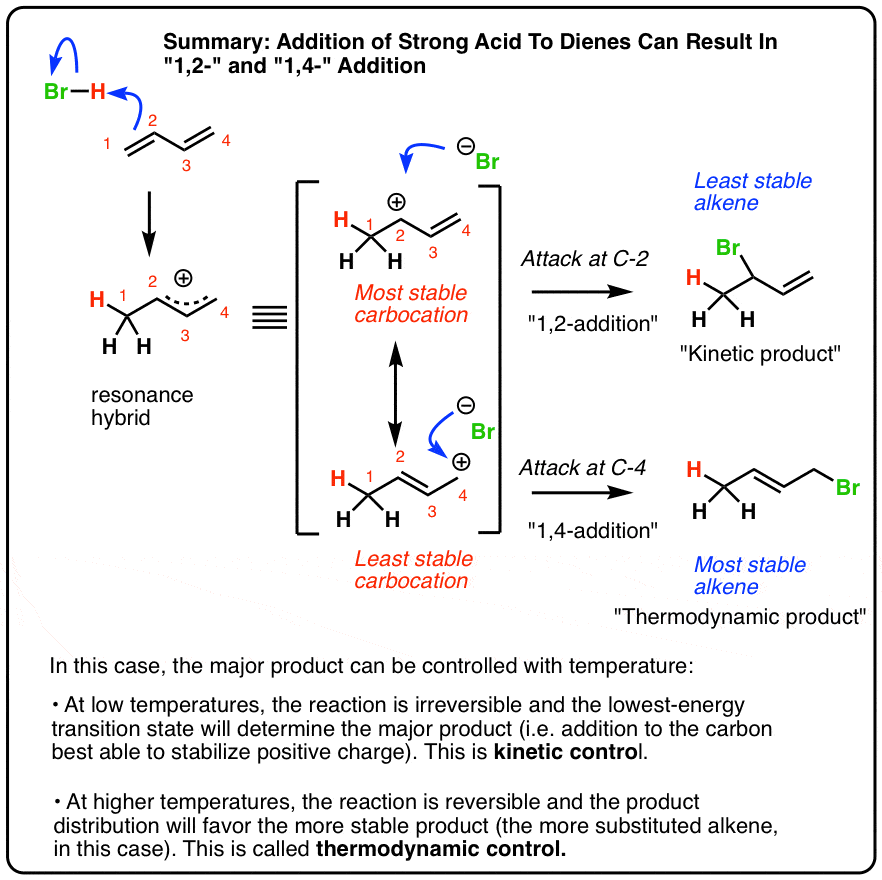
Table of Contents
- Addition To Alkenes, Revisited
- Reaction Of Butadiene With Acid Gives “1,2-Addition” And “1,4-Addition” Products
- The “1,4 Addition” Product Of Acids Adding To Butadiene
- Protonation Of Butadiene Gives A Resonance-Stabilized Carbocation
- The Effect Of Temperature: Low Temperatures Give “1,2” Addition To Butadiene
- Higher Temperatures Give More Of The “1,4” Product
- With Butadiene, The “1,4” Product Is More Stable Because It Has A More Substituted Double Bond
- “Kinetic Control” vs “Thermodynamic Control”: At Low Temperatures The Reaction Is Irreversible And Products Are Determined By Relative Rates
- Thermodynamic Control: At Higher Temperatures The Reaction Is Reversible And Product Distribution Is Determined By Stability
- Using An Energy Diagram To Understand Thermodynamic Versus Kinetic Control
- A Parting Word Of Warning: The “1,4-Product” Is Not Always The “Thermodynamic” Product
- Other Reactions Can Give 1,2- and 1,4- Additions As Well
- Notes
- Quiz Yourself!
- (Advanced) References and Further Reading
1. Addition To Alkenes, Revisited
Waaay back in the day we talked about addition reactions of alkenes. Remember Markovnikov’s rule in the addition of electrophiles to alkenes?
For example, take an alkene like 1-butene, and add HBr. What happens?

An addition reaction occurs! (Break C-C pi, and form adjacent C-H and C-Br bonds).
Bromine adds to the most substituted carbon of the alkene, and hydrogen adds to the least substituted carbon. That’s due to carbocation stability: the reaction proceeds through the most stable carbocation, which happens to be the most substituted.
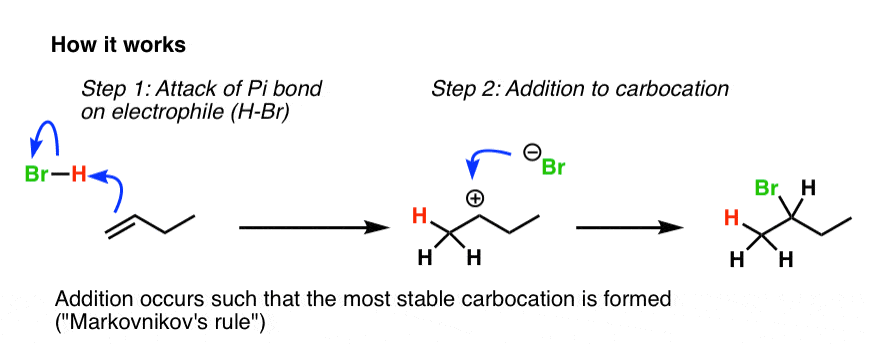
2. Reaction Of Butadiene With Acid Gives “1,2-Addition” And “1,4-Addition” Products
All well and good. But since we’ve been discussing conjugation and resonance, let’s throw in an additional wrinkle.
What happens when we try the same reaction on a diene? Butadiene, for example.

I’ll tell you. You get two products! (But the second one might not be what you think it is).
Here’s what they look like:
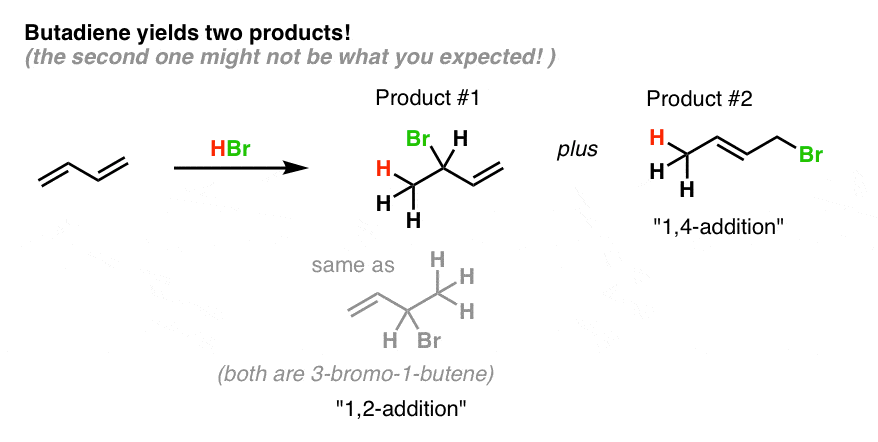
Product #1 is essentially the same product that we saw in the 1-butene example: H and Br are added across two consecutive carbons of a double bond. Note that since butadiene is symmetric, the same product is formed regardless of which double bond participates! (we get 3-bromo-1-butene either way).
Since addition occurs across two consecutive carbons, we often call this “1,2 addition”.
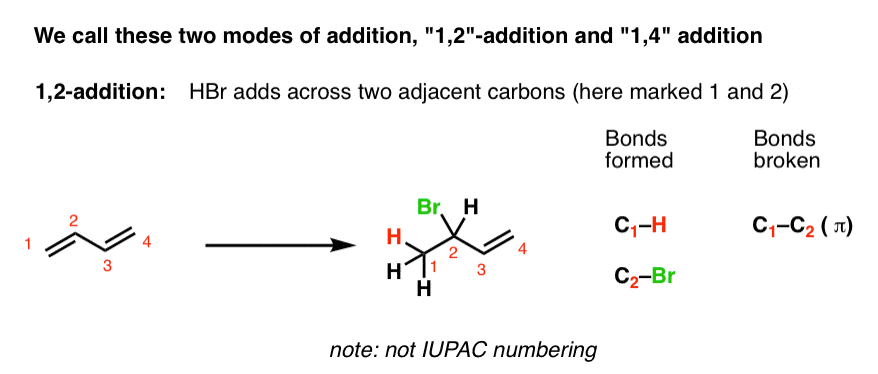
3. The “1,4 Addition” Product Of Acids Adding To Butadiene
In contrast, Product #2 shows the result of adding H and Br across four conjugated carbons. All four carbons participate in the reaction. A new C-H single bond has formed on one end of the diene (C-1), and C-Br formed on the other end (C-4). Note that the C1-C2 and C3-C4 pi bonds are broken, and we’ve formed a new pi bond between C2 and C3.
We call this “1,4 addition”.
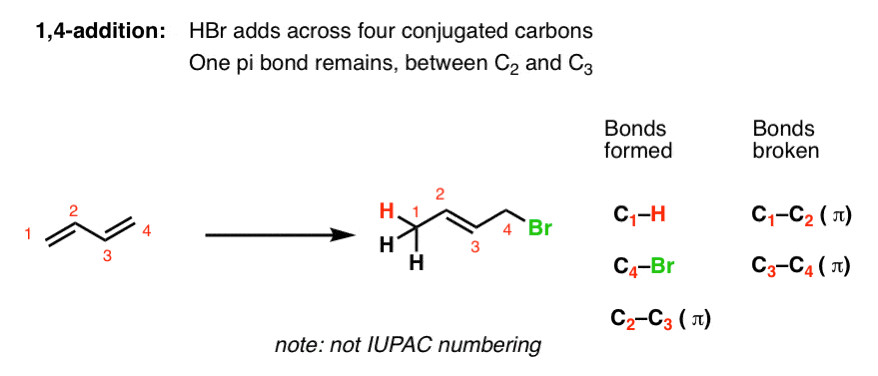
[Note: to simplify the discussion here, I’m choosing to ignore double bond isomers (i.e. E and Z) in this analysis. In the lab, the 1,4- example above will exist as a mixture of (mostly) E product with a small amount of the Z. ]
So why does this “1,4 addition” happen in the first place? What’s different about butadiene, as opposed to 1-butene where only “1,2-addition” was possible?
4. Protonation Of Butadiene Gives A Resonance-Stabilized Carbocation
The first thing to notice is that the initial protonation of butadiene gives a resonance-stabilized carbocation. See how protonation of C-1 gives a carbocation that has two important resonance forms?

In the case of butadiene,
- the major contributor to the resonance hybrid will be the resonance form where the carbocation is on the more substituted carbocation (C2)
- the minor contributor will be the resonance form where the carbocation is on the less substituted carbocation (C4).
Attack of the nucleophile (Br–) at the C2 position of the hybrid will lead to the 1,2-product.
Attack of Br– at the C4 position of the resonance hybrid will lead to the 1,4-product.
[Note: never forget that resonance forms are not in equilibrium with each other. It’s understandable to casually say that “Br(–) will attack the top resonance form with the more stable carbocation” so long as you remember that the true structure of the molecule is a hybrid of the two resonance forms.] In the footnote, I’m including perhaps a more correct way to show formation of the bottom resonance form.
5. The Effect Of Temperature: Low Temperatures Give “1,2” Addition To Butadiene
Here’s the big question: which one of the two products will be major? The 1,2-addition product or the 1,4-addition product?
We’re so used to seeing “Markovnikov addition” in alkenes (where addition occurs to the most stable carbocation) that it seems intuitive that the 1,2-addition product would be dominant.
And indeed, at low temperature, 1,2 addition to butadiene is favoured. Here’s a literature example.
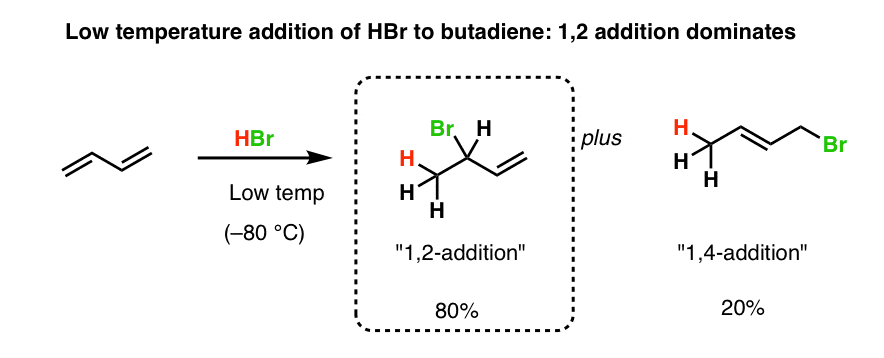
6. Higher Temperatures Give More Of The “1,4” Product
Interestingly, however, as the temperature is increased, the amount of 1,4 product increases.
At room temperature, the ratio of 1,2- and 1,4- addition is 45:55 .
At 40 degrees Celsius the 1,4- product is dominant (about 80%).
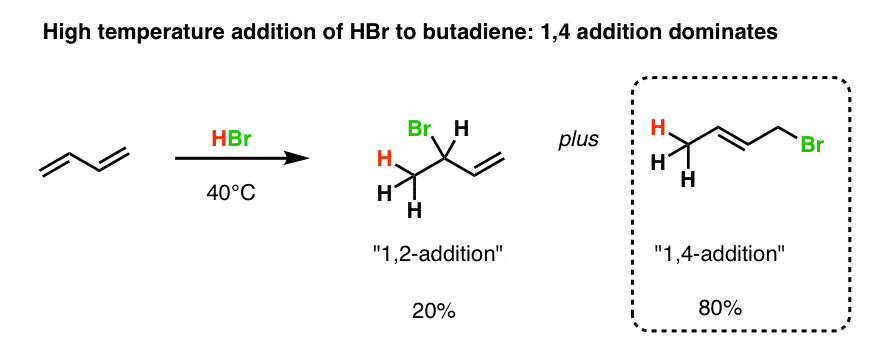
7. With Butadiene, The “1,4” Product Is More Stable Because It Has A More Substituted Double Bond
What’s going on here? What structural features are present that could possibly make formation of the 1,4 product more favourable than the 1,2 product, even though it goes through a “less stable” carbocation?
The answer lies in the substitution pattern of the double bond.
Remember Zaitsev’s rule? Same deal. The 1,4 product is more stable because it is a more substituted double bond.
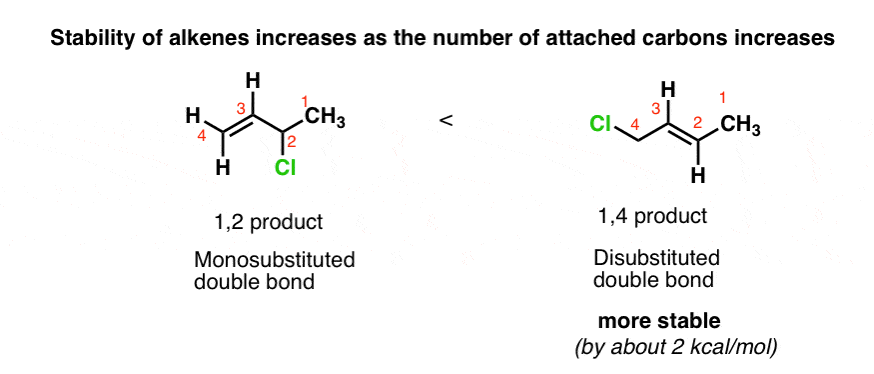
The 1,4 product has a di-substituted double bond, whereas the 1,2-product has a mono-substituted double bond. Generally speaking, double bond stability increases as the number of carbons directly attached to the double bond is increased. (See article: Alkene Stability)
So why would 1,4 be more favoured under conditions of higher temperature, and the 1,2 be favoured under conditions of lower temperature?
8. “Kinetic Control” vs “Thermodynamic Control”: At Low Temperatures The Reaction Is Irreversible And Products Are Determined By Relative Rates
At low temperatures, the differentiating factor is the relative energies of the transition states leading to the products. The 1,2 product has a lower-energy transition state, owing to the fact that charge is more stable on the more substituted carbon. The difference between the energies of these transition states will determine the product ratio.
A quick analogy. Imagine you’re hungry, and you only have $5 in your pocket. In a choice between McDonalds and Applebee’s, the only accessible option is McDonalds – even if, for some reason, you like Applebee’s a lot more.
Let’s sketch this out. The carbocation intermediate can pass through the two different transition states that lead to the 1,2- and 1,4- products, respectively. If we choose a temperature low enough, then the product distribution will reflect the difference in energy between the two activation energies Ea (1,2) and Ea (1,4). So long as the reaction is not reversible, the product with the lower energy transition state will dominate. This is called “kinetic control”.
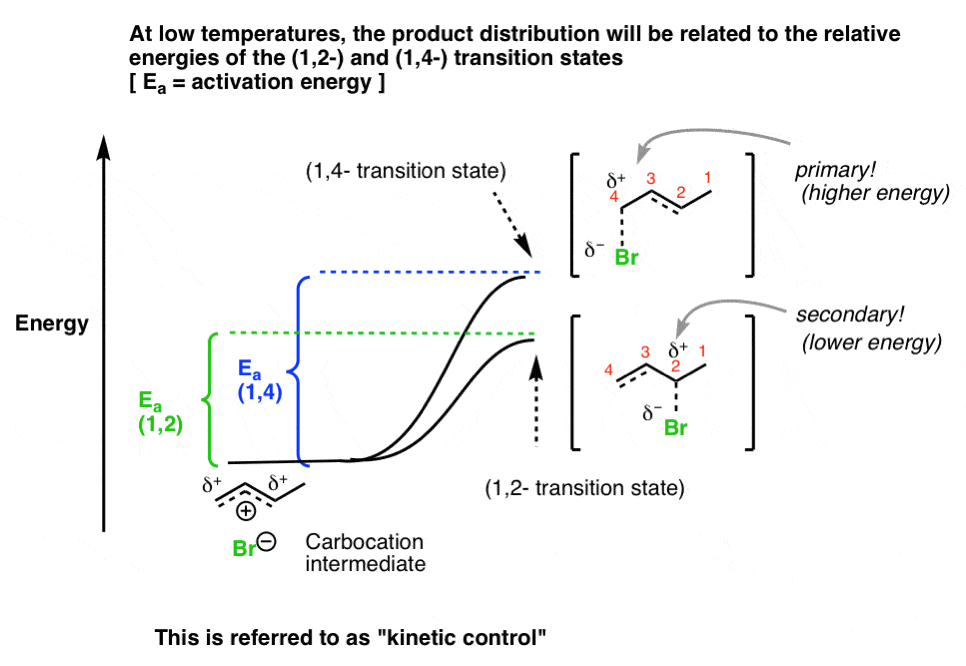
9. Thermodynamic Control: At Higher Temperatures The Reaction Is Reversible And Product Distribution Is Determined By Stability
At higher temperatures, the reaction has the potential to be reversible. [Note 2] In this case, this means is that both the 1,2- and 1,4- products can ionize (think of the first step in the SN1 reaction), reforming the carbocation intermediate.
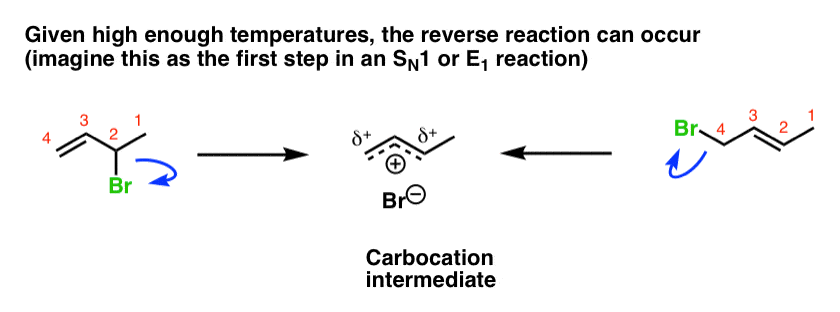
This sets up an equilibrium. The product ratio will now reflect the relative stabilities of the 1,2- and 1,4- products, not the transition states leading to their formation. In the case of butadiene, since the 1,4- product is more stable (it has a disubstituted double bond) it will be the dominant product at higher temperatures.
This is referred to as “thermodynamic control“.
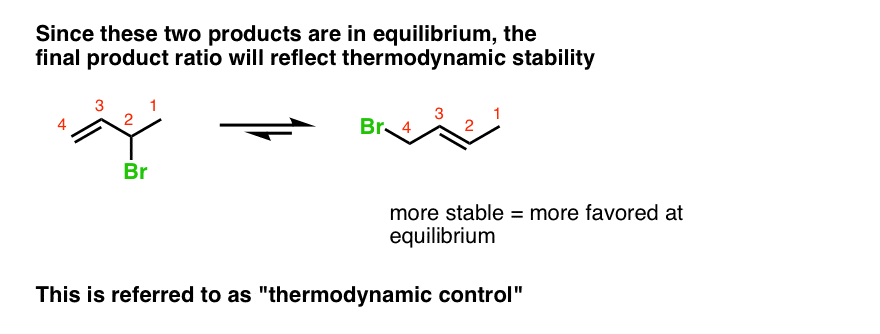
Math interlude: recall that ΔG = –RT lnK
A difference of 1 kcal/mol in stability doesn’t sound like much, but it translates into a 83:17 ratio of products at equilibrium at room temperature.
Continuing our analogy: with enough money in your pocket, the decision where to eat lunch is more a function of how much you like the overall McDonalds vs. Applebee’s experiences, not how much they cost.
10. Using An Energy Diagram To Understand Thermodynamic Versus Kinetic Control
Drawing up the reaction energy diagram can be helpful to understand kinetic and thermodynamic control. This post here goes into more detail, but we’ll repeat the basics here.
The reaction energy diagram for the addition of HBr to butadiene looks like this:
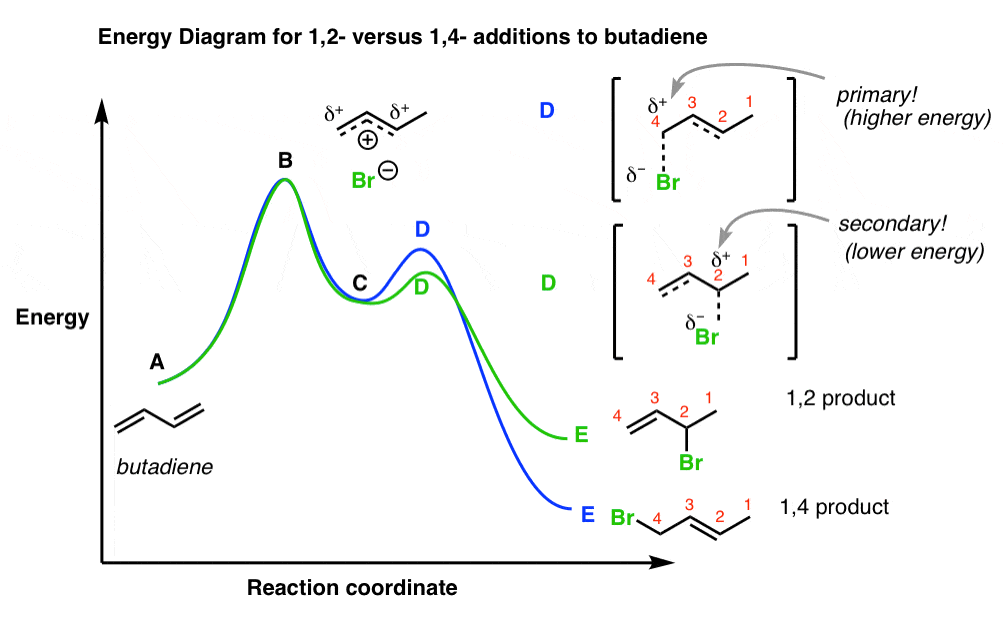
Point A is the starting butadiene, and point B is the transition state for addition of H to butadiene.
The important part to pay attention to is the “local minimum” C, the resonance-stabilized carbocation.
As we mentioned previously, going from intermediate C to transition states D and D represent the energy pathways for 1,2- and 1,4- addition, respectively.
Hence the activation energies for the forward reactions is equal to the difference in energy between D and C (for 1,2-addition) and D and C (for 1,4-addition). We saw that 1,2-addition has a lower activation energy.
Now let’s look at the reverse reaction.
Points E and E represent the energies of the 1,2- and 1,4- products.
The activation energy for the reverse reaction is the difference in energy between E and transition state D, and E and transition state D, respectively.
It should be clear from this diagram that the activation energies for the forward reaction (going from C through transition states D and D give E and E, respectively) are much lower than the activation energies going in the reverse reaction (i.e. from E and E through transition states D and D back to carbocation C ).
- So if we keep the temperature low, we favor the forward reaction and hinder the reverse, and obtain the kinetic product.
- If the temperature is raised, the reverse reaction becomes energetically accessible, and equilibrium is established. We will then obtain the thermodynamic product.
11.A Parting Word Of Warning: The “1,4-Product” Is Not Always The “Thermodynamic” Product
Let’s summarize. Understanding the following two factors is key to correctly answering exam problems.
The relative importance of the carbocation resonance forms- The relative stabilities of the double bond products.
In the case of butadiene, it is true that the 1,2 product was formed through a more stable carbocation (kinetic product), and the 1,4 product had a more stable double bond (thermodynamic product).
But it will not always be true for all dienes!!
Here are three examples that will help you think through the main issues (answers in the next post).

12. Other Reactions Can Give 1,2- and 1,4- Additions As Well
This post is long enough, but I would be remiss if I failed to note that 1,2 and 1,4 additions to dienes are also possible for a few other classes of reaction.
- Addition of HBr to dienes under free-radical conditions (e.g. HBr + peroxides)
- Addition of Br2 (and Cl2) to dienes.
Note that similar issues will arise (i.e. stability of a reactive intermediate versus stability of the final product). We’ll go into more detail when the time comes.
Many thanks to Tom Struble for help with preparing this post.
Notes
Related Articles
Note 1. All the textbooks I consulted showed diagrams similar to what I drew above, with Br(-) attacking different resonance forms. Perhaps a more correct way to draw the formation of the carbocation at the 4-position is to show it like this.

Quiz Yourself!
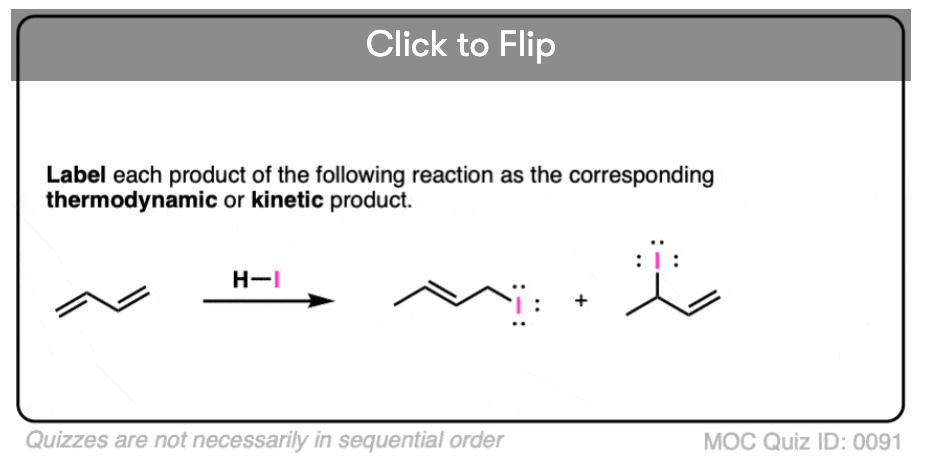
Become a MOC member to see the clickable quiz with answers on the back.
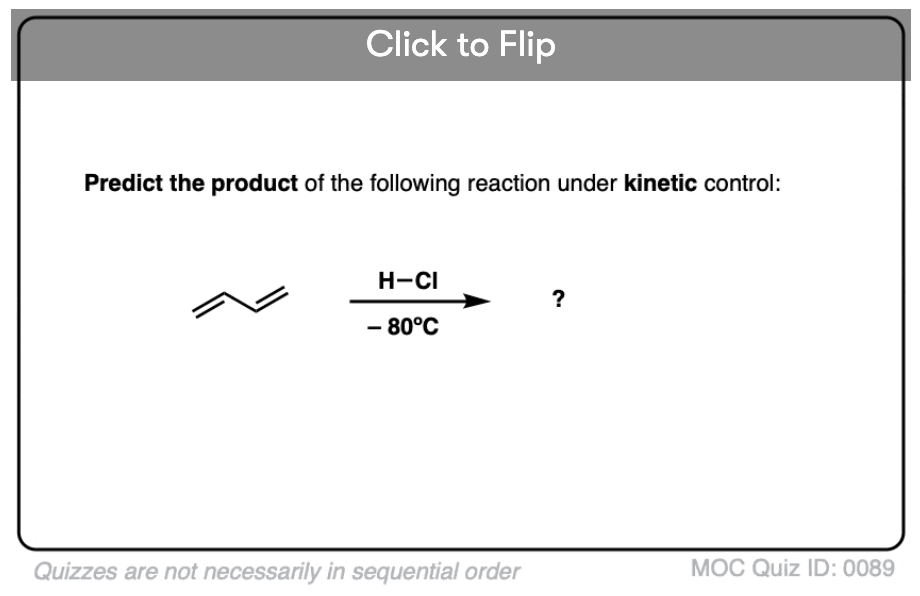
Become a MOC member to see the clickable quiz with answers on the back.
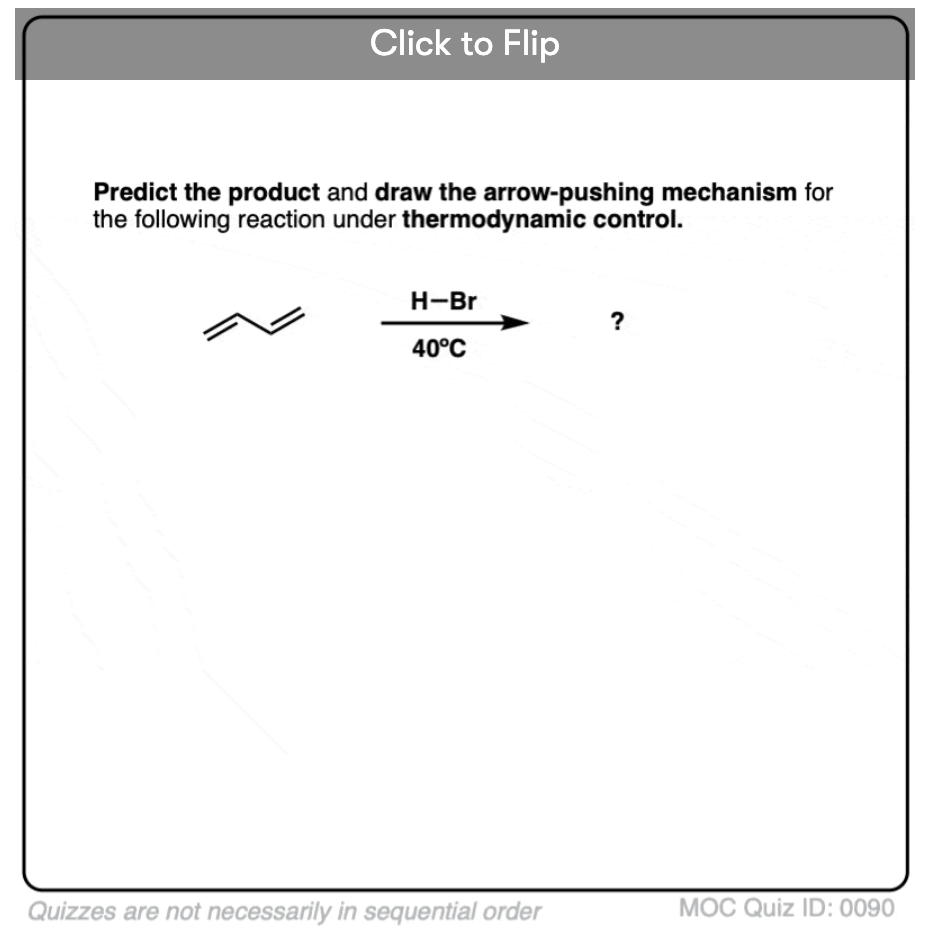
Become a MOC member to see the clickable quiz with answers on the back.
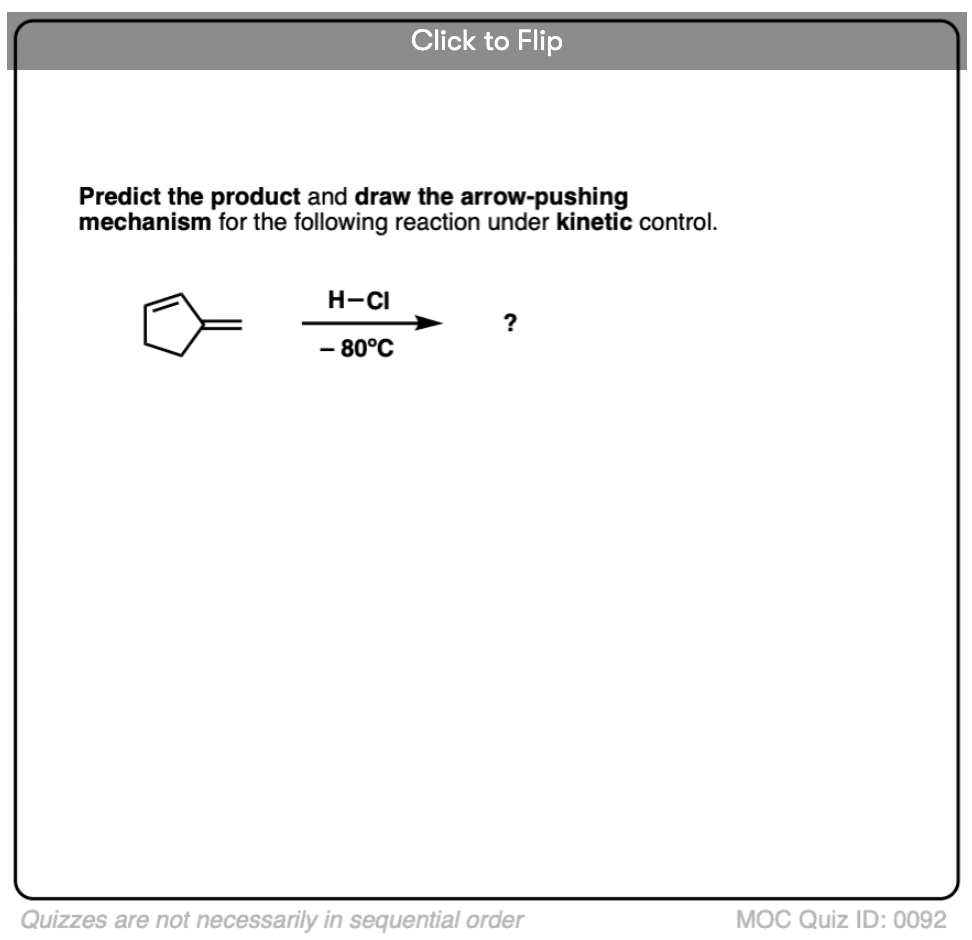
Become a MOC member to see the clickable quiz with answers on the back.
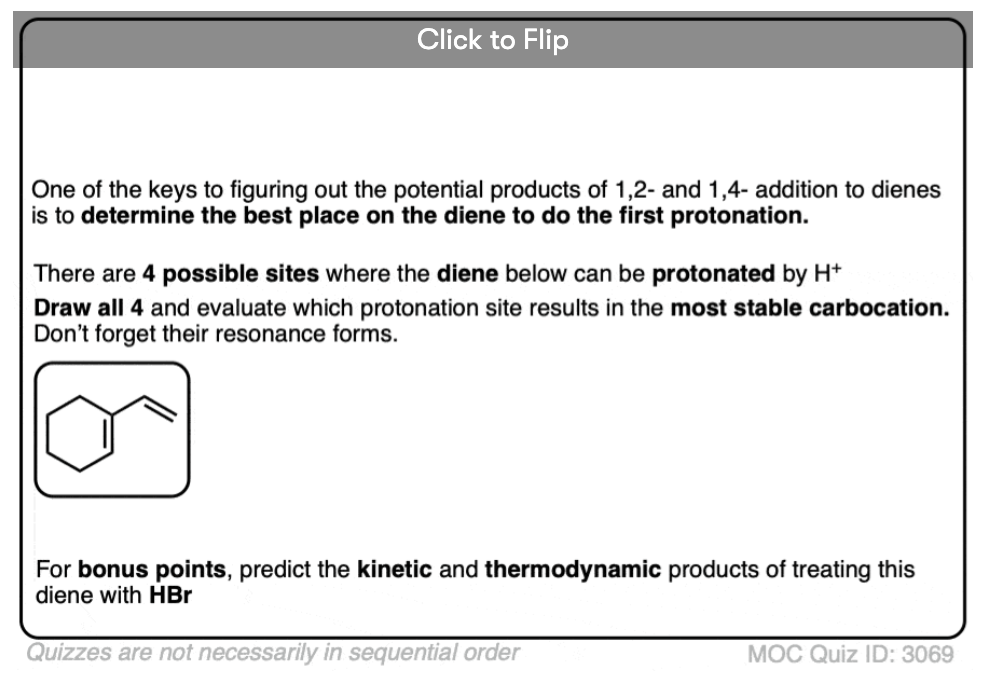
Become a MOC member to see the clickable quiz with answers on the back.
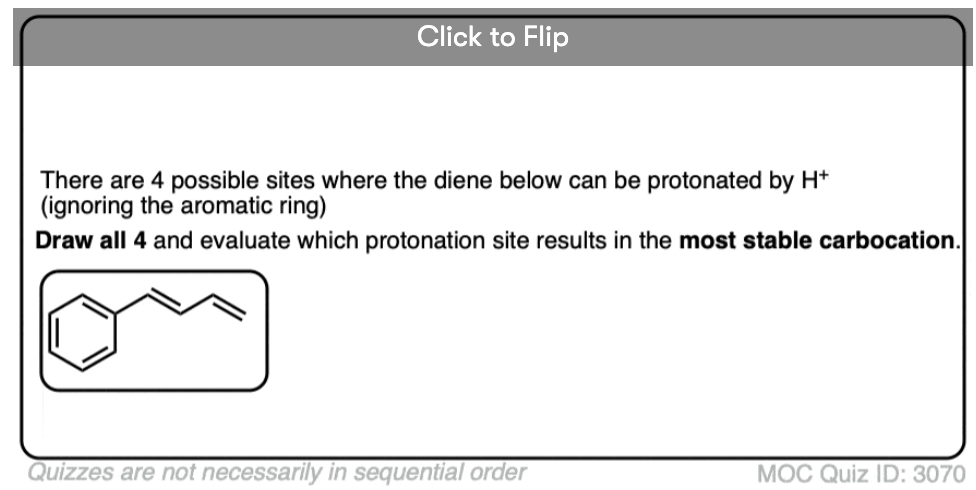
Become a MOC member to see the clickable quiz with answers on the back.
(Advanced) References and Further Reading
- THE ADDITION OF HYDROGEN CHLORIDE TO BUTADIENE
M. S. KHARASCH, J. KRITCHEVSKY, and F. R. MAYO
The Journal of Organic Chemistry 1937, 02 (5), 489-496
DOI: 10.1021/jo01228a010
An early paper by the esteemed chemist M. S. Kharasch on the addition of HCl to butadiene, seeing whether the ratio of 1,2 to 1,4 addition varied with different reaction conditions. - THE PEROXIDE EFFECT IN THE ADDITION OF REAGENTS TO UNSATURATED COMPOUNDS. XIII. THE ADDITION OF HYDROGEN BROMIDE TO BUTADIENE
M. S. KHARASCH, ELLY T. MARGOLIS, and FRANK R. MAYO
The Journal of Organic Chemistry 1936, 01 (4), 393-404
DOI: 10.1021/jo01233a008
Another early study by M. S. Kharasch in which he studies the addition of HBr to butadiene, in which he attempts to rigorously separate the two modes of addition – electrophilic vs. radical. - —Mobile-anion tautomerism. Part I. A preliminary study of the conditions of activation of the three-carbon system, and a discussion of the results in relation to the modes of addition to conjugated systems
Harold Burton and Christopher Kelk Ingold
J. Chem. Soc. 1928, 904-921
DOI: 10.1039/JR9280000904
A classic paper from a pioneer of physical organic chemistry, Prof. C. K. Ingold. He suggests the general idea that the 1,2 and 1,4 addition products are in equilibrium and that the 1,2-product can reverse reaction and form the 1,4 product. This is the basis of what we now call “kinetic” and “thermodynamic” control. - The modes of addition to conjugated unsaturated systems. Part IX. A discussion of mechanism and equilibrium, with a note on three-carbon prototropy
P. B. D. de la Mare, E. D. Hughes and C. K. Ingold
J. Chem. Soc. 1948, 17
DOI: 10.1039/JR9480000017
Here, C. K. Ingold has reviewed all work (including Kharasch’s) done up to that point in the study of electrophilic additions to conjugated systems. - Properties of conjugated compounds. Part XI. Addition of hydrogen bromide to βγ- and αδ-dimethylbutadiene
Ernest Harold Farmer and Frederick G. B. Marshall
J. Chem. Soc. 1931, 129
DOI: 10.1039/JR9310000129
When methyl groups are added to butadiene, the 1,2 and 1,4 addition ratios can change significantly! This is because the stability of the carbocation intermediates will change.
00 General Chemistry Review
01 Bonding, Structure, and Resonance
- How Do We Know Methane (CH4) Is Tetrahedral?
- Hybrid Orbitals and Hybridization
- How To Determine Hybridization: A Shortcut
- Orbital Hybridization And Bond Strengths
- Sigma bonds come in six varieties: Pi bonds come in one
- A Key Skill: How to Calculate Formal Charge
- The Four Intermolecular Forces and How They Affect Boiling Points
- 3 Trends That Affect Boiling Points
- How To Use Electronegativity To Determine Electron Density (and why NOT to trust formal charge)
- Introduction to Resonance
- How To Use Curved Arrows To Interchange Resonance Forms
- Evaluating Resonance Forms (1) - The Rule of Least Charges
- How To Find The Best Resonance Structure By Applying Electronegativity
- Evaluating Resonance Structures With Negative Charges
- Evaluating Resonance Structures With Positive Charge
- Exploring Resonance: Pi-Donation
- Exploring Resonance: Pi-acceptors
- In Summary: Evaluating Resonance Structures
- Drawing Resonance Structures: 3 Common Mistakes To Avoid
- How to apply electronegativity and resonance to understand reactivity
- Bond Hybridization Practice
- Structure and Bonding Practice Quizzes
- Resonance Structures Practice
02 Acid Base Reactions
- Introduction to Acid-Base Reactions
- Acid Base Reactions In Organic Chemistry
- The Stronger The Acid, The Weaker The Conjugate Base
- Walkthrough of Acid-Base Reactions (3) - Acidity Trends
- Five Key Factors That Influence Acidity
- Acid-Base Reactions: Introducing Ka and pKa
- How to Use a pKa Table
- The pKa Table Is Your Friend
- A Handy Rule of Thumb for Acid-Base Reactions
- Acid Base Reactions Are Fast
- pKa Values Span 60 Orders Of Magnitude
- How Protonation and Deprotonation Affect Reactivity
- Acid Base Practice Problems
03 Alkanes and Nomenclature
- Meet the (Most Important) Functional Groups
- Condensed Formulas: Deciphering What the Brackets Mean
- Hidden Hydrogens, Hidden Lone Pairs, Hidden Counterions
- Don't Be Futyl, Learn The Butyls
- Primary, Secondary, Tertiary, Quaternary In Organic Chemistry
- Branching, and Its Affect On Melting and Boiling Points
- The Many, Many Ways of Drawing Butane
- Wedge And Dash Convention For Tetrahedral Carbon
- Common Mistakes in Organic Chemistry: Pentavalent Carbon
- Table of Functional Group Priorities for Nomenclature
- Summary Sheet - Alkane Nomenclature
- Organic Chemistry IUPAC Nomenclature Demystified With A Simple Puzzle Piece Approach
- Boiling Point Quizzes
- Organic Chemistry Nomenclature Quizzes
04 Conformations and Cycloalkanes
- Staggered vs Eclipsed Conformations of Ethane
- Conformational Isomers of Propane
- Newman Projection of Butane (and Gauche Conformation)
- Introduction to Cycloalkanes
- Geometric Isomers In Small Rings: Cis And Trans Cycloalkanes
- Calculation of Ring Strain In Cycloalkanes
- Cycloalkanes - Ring Strain In Cyclopropane And Cyclobutane
- Cyclohexane Conformations
- Cyclohexane Chair Conformation: An Aerial Tour
- How To Draw The Cyclohexane Chair Conformation
- The Cyclohexane Chair Flip
- The Cyclohexane Chair Flip - Energy Diagram
- Substituted Cyclohexanes - Axial vs Equatorial
- Ranking The Bulkiness Of Substituents On Cyclohexanes: "A-Values"
- Cyclohexane Chair Conformation Stability: Which One Is Lower Energy?
- Fused Rings - Cis-Decalin and Trans-Decalin
- Naming Bicyclic Compounds - Fused, Bridged, and Spiro
- Bredt's Rule (And Summary of Cycloalkanes)
- Newman Projection Practice
- Cycloalkanes Practice Problems
05 A Primer On Organic Reactions
- The Most Important Question To Ask When Learning a New Reaction
- Curved Arrows (for reactions)
- Nucleophiles and Electrophiles
- The Three Classes of Nucleophiles
- Nucleophilicity vs. Basicity
- What Makes A Good Nucleophile?
- What Makes A Good Leaving Group?
- 3 Factors That Stabilize Carbocations
- Equilibrium and Energy Relationships
- 7 Factors that stabilize negative charge in organic chemistry
- 7 Factors That Stabilize Positive Charge in Organic Chemistry
- What's a Transition State?
- Hammond's Postulate
- Learning Organic Chemistry Reactions: A Checklist (PDF)
- Introduction to Oxidative Cleavage Reactions
06 Free Radical Reactions
- Bond Dissociation Energies = Homolytic Cleavage
- Free Radical Reactions
- 3 Factors That Stabilize Free Radicals
- What Factors Destabilize Free Radicals?
- Bond Strengths And Radical Stability
- Free Radical Initiation: Why Is "Light" Or "Heat" Required?
- Initiation, Propagation, Termination
- Monochlorination Products Of Propane, Pentane, And Other Alkanes
- Selectivity In Free Radical Reactions
- Selectivity in Free Radical Reactions: Bromination vs. Chlorination
- Halogenation At Tiffany's
- Allylic Bromination
- Bonus Topic: Allylic Rearrangements
- In Summary: Free Radicals
- Synthesis (2) - Reactions of Alkanes
- Free Radicals Practice Quizzes
07 Stereochemistry and Chirality
- Types of Isomers: Constitutional Isomers, Stereoisomers, Enantiomers, and Diastereomers
- How To Draw The Enantiomer Of A Chiral Molecule
- How To Draw A Bond Rotation
- Introduction to Assigning (R) and (S): The Cahn-Ingold-Prelog Rules
- Assigning Cahn-Ingold-Prelog (CIP) Priorities (2) - The Method of Dots
- Enantiomers vs Diastereomers vs The Same? Two Methods For Solving Problems
- Assigning R/S To Newman Projections (And Converting Newman To Line Diagrams)
- How To Determine R and S Configurations On A Fischer Projection
- The Meso Trap
- Optical Rotation, Optical Activity, and Specific Rotation
- Optical Purity and Enantiomeric Excess
- What's a Racemic Mixture?
- Chiral Allenes And Chiral Axes
- Stereochemistry Practice Problems and Quizzes
08 Substitution Reactions
- Nucleophilic Substitution Reactions - Introduction
- Two Types of Nucleophilic Substitution Reactions
- The SN2 Mechanism
- Why the SN2 Reaction Is Powerful
- The SN1 Mechanism
- The Conjugate Acid Is A Better Leaving Group
- Comparing the SN1 and SN2 Reactions
- Polar Protic? Polar Aprotic? Nonpolar? All About Solvents
- Steric Hindrance is Like a Fat Goalie
- Common Blind Spot: Intramolecular Reactions
- Substitution Practice - SN1
- Substitution Practice - SN2
09 Elimination Reactions
- Elimination Reactions (1): Introduction And The Key Pattern
- Elimination Reactions (2): The Zaitsev Rule
- Elimination Reactions Are Favored By Heat
- Two Elimination Reaction Patterns
- The E1 Reaction
- The E2 Mechanism
- E1 vs E2: Comparing the E1 and E2 Reactions
- Antiperiplanar Relationships: The E2 Reaction and Cyclohexane Rings
- Bulky Bases in Elimination Reactions
- Comparing the E1 vs SN1 Reactions
- Elimination (E1) Reactions With Rearrangements
- E1cB - Elimination (Unimolecular) Conjugate Base
- Elimination (E1) Practice Problems And Solutions
- Elimination (E2) Practice Problems and Solutions
10 Rearrangements
11 SN1/SN2/E1/E2 Decision
- Identifying Where Substitution and Elimination Reactions Happen
- Deciding SN1/SN2/E1/E2 (1) - The Substrate
- Deciding SN1/SN2/E1/E2 (2) - The Nucleophile/Base
- SN1 vs E1 and SN2 vs E2 : The Temperature
- Deciding SN1/SN2/E1/E2 - The Solvent
- Wrapup: The Key Factors For Determining SN1/SN2/E1/E2
- Alkyl Halide Reaction Map And Summary
- SN1 SN2 E1 E2 Practice Problems
12 Alkene Reactions
- E and Z Notation For Alkenes (+ Cis/Trans)
- Alkene Stability
- Alkene Addition Reactions: "Regioselectivity" and "Stereoselectivity" (Syn/Anti)
- Stereoselective and Stereospecific Reactions
- Hydrohalogenation of Alkenes and Markovnikov's Rule
- Hydration of Alkenes With Aqueous Acid
- Rearrangements in Alkene Addition Reactions
- Halogenation of Alkenes and Halohydrin Formation
- Oxymercuration Demercuration of Alkenes
- Hydroboration Oxidation of Alkenes
- m-CPBA (meta-chloroperoxybenzoic acid)
- OsO4 (Osmium Tetroxide) for Dihydroxylation of Alkenes
- Palladium on Carbon (Pd/C) for Catalytic Hydrogenation of Alkenes
- Cyclopropanation of Alkenes
- A Fourth Alkene Addition Pattern - Free Radical Addition
- Alkene Reactions: Ozonolysis
- Summary: Three Key Families Of Alkene Reaction Mechanisms
- Synthesis (4) - Alkene Reaction Map, Including Alkyl Halide Reactions
- Alkene Reactions Practice Problems
13 Alkyne Reactions
- Acetylides from Alkynes, And Substitution Reactions of Acetylides
- Partial Reduction of Alkynes With Lindlar's Catalyst
- Partial Reduction of Alkynes With Na/NH3 To Obtain Trans Alkenes
- Alkyne Hydroboration With "R2BH"
- Hydration and Oxymercuration of Alkynes
- Hydrohalogenation of Alkynes
- Alkyne Halogenation: Bromination, Chlorination, and Iodination of Alkynes
- Alkyne Reactions - The "Concerted" Pathway
- Alkenes To Alkynes Via Halogenation And Elimination Reactions
- Alkynes Are A Blank Canvas
- Synthesis (5) - Reactions of Alkynes
- Alkyne Reactions Practice Problems With Answers
14 Alcohols, Epoxides and Ethers
- Alcohols - Nomenclature and Properties
- Alcohols Can Act As Acids Or Bases (And Why It Matters)
- Alcohols - Acidity and Basicity
- The Williamson Ether Synthesis
- Ethers From Alkenes, Tertiary Alkyl Halides and Alkoxymercuration
- Alcohols To Ethers via Acid Catalysis
- Cleavage Of Ethers With Acid
- Epoxides - The Outlier Of The Ether Family
- Opening of Epoxides With Acid
- Epoxide Ring Opening With Base
- Making Alkyl Halides From Alcohols
- Tosylates And Mesylates
- PBr3 and SOCl2
- Elimination Reactions of Alcohols
- Elimination of Alcohols To Alkenes With POCl3
- Alcohol Oxidation: "Strong" and "Weak" Oxidants
- Demystifying The Mechanisms of Alcohol Oxidations
- Protecting Groups For Alcohols
- Thiols And Thioethers
- Calculating the oxidation state of a carbon
- Oxidation and Reduction in Organic Chemistry
- Oxidation Ladders
- SOCl2 Mechanism For Alcohols To Alkyl Halides: SN2 versus SNi
- Alcohol Reactions Roadmap (PDF)
- Alcohol Reaction Practice Problems
- Epoxide Reaction Quizzes
- Oxidation and Reduction Practice Quizzes
15 Organometallics
- What's An Organometallic?
- Formation of Grignard and Organolithium Reagents
- Organometallics Are Strong Bases
- Reactions of Grignard Reagents
- Protecting Groups In Grignard Reactions
- Synthesis Problems Involving Grignard Reagents
- Grignard Reactions And Synthesis (2)
- Organocuprates (Gilman Reagents): How They're Made
- Gilman Reagents (Organocuprates): What They're Used For
- The Heck, Suzuki, and Olefin Metathesis Reactions (And Why They Don't Belong In Most Introductory Organic Chemistry Courses)
- Reaction Map: Reactions of Organometallics
- Grignard Practice Problems
16 Spectroscopy
- Degrees of Unsaturation (or IHD, Index of Hydrogen Deficiency)
- Conjugation And Color (+ How Bleach Works)
- Introduction To UV-Vis Spectroscopy
- UV-Vis Spectroscopy: Absorbance of Carbonyls
- UV-Vis Spectroscopy: Practice Questions
- Bond Vibrations, Infrared Spectroscopy, and the "Ball and Spring" Model
- Infrared Spectroscopy: A Quick Primer On Interpreting Spectra
- IR Spectroscopy: 4 Practice Problems
- 1H NMR: How Many Signals?
- Homotopic, Enantiotopic, Diastereotopic
- Diastereotopic Protons in 1H NMR Spectroscopy: Examples
- 13-C NMR - How Many Signals
- Liquid Gold: Pheromones In Doe Urine
- Natural Product Isolation (1) - Extraction
- Natural Product Isolation (2) - Purification Techniques, An Overview
- Structure Determination Case Study: Deer Tarsal Gland Pheromone
17 Dienes and MO Theory
- What To Expect In Organic Chemistry 2
- Are these molecules conjugated?
- Conjugation And Resonance In Organic Chemistry
- Bonding And Antibonding Pi Orbitals
- Molecular Orbitals of The Allyl Cation, Allyl Radical, and Allyl Anion
- Pi Molecular Orbitals of Butadiene
- Reactions of Dienes: 1,2 and 1,4 Addition
- Thermodynamic and Kinetic Products
- More On 1,2 and 1,4 Additions To Dienes
- s-cis and s-trans
- The Diels-Alder Reaction
- Cyclic Dienes and Dienophiles in the Diels-Alder Reaction
- Stereochemistry of the Diels-Alder Reaction
- Exo vs Endo Products In The Diels Alder: How To Tell Them Apart
- HOMO and LUMO In the Diels Alder Reaction
- Why Are Endo vs Exo Products Favored in the Diels-Alder Reaction?
- Diels-Alder Reaction: Kinetic and Thermodynamic Control
- The Retro Diels-Alder Reaction
- The Intramolecular Diels Alder Reaction
- Regiochemistry In The Diels-Alder Reaction
- The Cope and Claisen Rearrangements
- Electrocyclic Reactions
- Electrocyclic Ring Opening And Closure (2) - Six (or Eight) Pi Electrons
- Diels Alder Practice Problems
- Molecular Orbital Theory Practice
18 Aromaticity
- Introduction To Aromaticity
- Rules For Aromaticity
- Huckel's Rule: What Does 4n+2 Mean?
- Aromatic, Non-Aromatic, or Antiaromatic? Some Practice Problems
- Antiaromatic Compounds and Antiaromaticity
- The Pi Molecular Orbitals of Benzene
- The Pi Molecular Orbitals of Cyclobutadiene
- Frost Circles
- Aromaticity Practice Quizzes
19 Reactions of Aromatic Molecules
- Electrophilic Aromatic Substitution: Introduction
- Activating and Deactivating Groups In Electrophilic Aromatic Substitution
- Electrophilic Aromatic Substitution - The Mechanism
- Ortho-, Para- and Meta- Directors in Electrophilic Aromatic Substitution
- Understanding Ortho, Para, and Meta Directors
- Why are halogens ortho- para- directors?
- Disubstituted Benzenes: The Strongest Electron-Donor "Wins"
- Electrophilic Aromatic Substitutions (1) - Halogenation of Benzene
- Electrophilic Aromatic Substitutions (2) - Nitration and Sulfonation
- EAS Reactions (3) - Friedel-Crafts Acylation and Friedel-Crafts Alkylation
- Intramolecular Friedel-Crafts Reactions
- Nucleophilic Aromatic Substitution (NAS)
- Nucleophilic Aromatic Substitution (2) - The Benzyne Mechanism
- Reactions on the "Benzylic" Carbon: Bromination And Oxidation
- The Wolff-Kishner, Clemmensen, And Other Carbonyl Reductions
- More Reactions on the Aromatic Sidechain: Reduction of Nitro Groups and the Baeyer Villiger
- Aromatic Synthesis (1) - "Order Of Operations"
- Synthesis of Benzene Derivatives (2) - Polarity Reversal
- Aromatic Synthesis (3) - Sulfonyl Blocking Groups
- Birch Reduction
- Synthesis (7): Reaction Map of Benzene and Related Aromatic Compounds
- Aromatic Reactions and Synthesis Practice
- Electrophilic Aromatic Substitution Practice Problems
20 Aldehydes and Ketones
- What's The Alpha Carbon In Carbonyl Compounds?
- Nucleophilic Addition To Carbonyls
- Aldehydes and Ketones: 14 Reactions With The Same Mechanism
- Sodium Borohydride (NaBH4) Reduction of Aldehydes and Ketones
- Grignard Reagents For Addition To Aldehydes and Ketones
- Wittig Reaction
- Hydrates, Hemiacetals, and Acetals
- Imines - Properties, Formation, Reactions, and Mechanisms
- All About Enamines
- Breaking Down Carbonyl Reaction Mechanisms: Reactions of Anionic Nucleophiles (Part 2)
- Aldehydes Ketones Reaction Practice
21 Carboxylic Acid Derivatives
- Nucleophilic Acyl Substitution (With Negatively Charged Nucleophiles)
- Addition-Elimination Mechanisms With Neutral Nucleophiles (Including Acid Catalysis)
- Basic Hydrolysis of Esters - Saponification
- Transesterification
- Proton Transfer
- Fischer Esterification - Carboxylic Acid to Ester Under Acidic Conditions
- Lithium Aluminum Hydride (LiAlH4) For Reduction of Carboxylic Acid Derivatives
- LiAlH[Ot-Bu]3 For The Reduction of Acid Halides To Aldehydes
- Di-isobutyl Aluminum Hydride (DIBAL) For The Partial Reduction of Esters and Nitriles
- Amide Hydrolysis
- Thionyl Chloride (SOCl2)
- Diazomethane (CH2N2)
- Carbonyl Chemistry: Learn Six Mechanisms For the Price Of One
- Making Music With Mechanisms (PADPED)
- Carboxylic Acid Derivatives Practice Questions
22 Enols and Enolates
- Keto-Enol Tautomerism
- Enolates - Formation, Stability, and Simple Reactions
- Kinetic Versus Thermodynamic Enolates
- Aldol Addition and Condensation Reactions
- Reactions of Enols - Acid-Catalyzed Aldol, Halogenation, and Mannich Reactions
- Claisen Condensation and Dieckmann Condensation
- Decarboxylation
- The Malonic Ester and Acetoacetic Ester Synthesis
- The Michael Addition Reaction and Conjugate Addition
- The Robinson Annulation
- Haloform Reaction
- The Hell–Volhard–Zelinsky Reaction
- Enols and Enolates Practice Quizzes
23 Amines
- The Amide Functional Group: Properties, Synthesis, and Nomenclature
- Basicity of Amines And pKaH
- 5 Key Basicity Trends of Amines
- The Mesomeric Effect And Aromatic Amines
- Nucleophilicity of Amines
- Alkylation of Amines (Sucks!)
- Reductive Amination
- The Gabriel Synthesis
- Some Reactions of Azides
- The Hofmann Elimination
- The Hofmann and Curtius Rearrangements
- The Cope Elimination
- Protecting Groups for Amines - Carbamates
- The Strecker Synthesis of Amino Acids
- Introduction to Peptide Synthesis
- Reactions of Diazonium Salts: Sandmeyer and Related Reactions
- Amine Practice Questions
24 Carbohydrates
- D and L Notation For Sugars
- Pyranoses and Furanoses: Ring-Chain Tautomerism In Sugars
- What is Mutarotation?
- Reducing Sugars
- The Big Damn Post Of Carbohydrate-Related Chemistry Definitions
- The Haworth Projection
- Converting a Fischer Projection To A Haworth (And Vice Versa)
- Reactions of Sugars: Glycosylation and Protection
- The Ruff Degradation and Kiliani-Fischer Synthesis
- Isoelectric Points of Amino Acids (and How To Calculate Them)
- Carbohydrates Practice
- Amino Acid Quizzes
25 Fun and Miscellaneous
- A Gallery of Some Interesting Molecules From Nature
- Screw Organic Chemistry, I'm Just Going To Write About Cats
- On Cats, Part 1: Conformations and Configurations
- On Cats, Part 2: Cat Line Diagrams
- On Cats, Part 4: Enantiocats
- On Cats, Part 6: Stereocenters
- Organic Chemistry Is Shit
- The Organic Chemistry Behind "The Pill"
- Maybe they should call them, "Formal Wins" ?
- Why Do Organic Chemists Use Kilocalories?
- The Principle of Least Effort
- Organic Chemistry GIFS - Resonance Forms
- Reproducibility In Organic Chemistry
- What Holds The Nucleus Together?
- How Reactions Are Like Music
- Organic Chemistry and the New MCAT
26 Organic Chemistry Tips and Tricks
- Common Mistakes: Formal Charges Can Mislead
- Partial Charges Give Clues About Electron Flow
- Draw The Ugly Version First
- Organic Chemistry Study Tips: Learn the Trends
- The 8 Types of Arrows In Organic Chemistry, Explained
- Top 10 Skills To Master Before An Organic Chemistry 2 Final
- Common Mistakes with Carbonyls: Carboxylic Acids... Are Acids!
- Planning Organic Synthesis With "Reaction Maps"
- Alkene Addition Pattern #1: The "Carbocation Pathway"
- Alkene Addition Pattern #2: The "Three-Membered Ring" Pathway
- Alkene Addition Pattern #3: The "Concerted" Pathway
- Number Your Carbons!
- The 4 Major Classes of Reactions in Org 1
- How (and why) electrons flow
- Grossman's Rule
- Three Exam Tips
- A 3-Step Method For Thinking Through Synthesis Problems
- Putting It Together
- Putting Diels-Alder Products in Perspective
- The Ups and Downs of Cyclohexanes
- The Most Annoying Exceptions in Org 1 (Part 1)
- The Most Annoying Exceptions in Org 1 (Part 2)
- The Marriage May Be Bad, But the Divorce Still Costs Money
- 9 Nomenclature Conventions To Know
- Nucleophile attacks Electrophile
27 Case Studies of Successful O-Chem Students
- Success Stories: How Corina Got The The "Hard" Professor - And Got An A+ Anyway
- How Helena Aced Organic Chemistry
- From a "Drop" To B+ in Org 2 – How A Hard Working Student Turned It Around
- How Serge Aced Organic Chemistry
- Success Stories: How Zach Aced Organic Chemistry 1
- Success Stories: How Kari Went From C– to B+
- How Esther Bounced Back From a "C" To Get A's In Organic Chemistry 1 And 2
- How Tyrell Got The Highest Grade In Her Organic Chemistry Course
- This Is Why Students Use Flashcards
- Success Stories: How Stu Aced Organic Chemistry
- How John Pulled Up His Organic Chemistry Exam Grades
- Success Stories: How Nathan Aced Organic Chemistry (Without It Taking Over His Life)
- How Chris Aced Org 1 and Org 2
- Interview: How Jay Got an A+ In Organic Chemistry
- How to Do Well in Organic Chemistry: One Student's Advice
- "America's Top TA" Shares His Secrets For Teaching O-Chem
- "Organic Chemistry Is Like..." - A Few Metaphors
- How To Do Well In Organic Chemistry: Advice From A Tutor
- Guest post: "I went from being afraid of tests to actually looking forward to them".
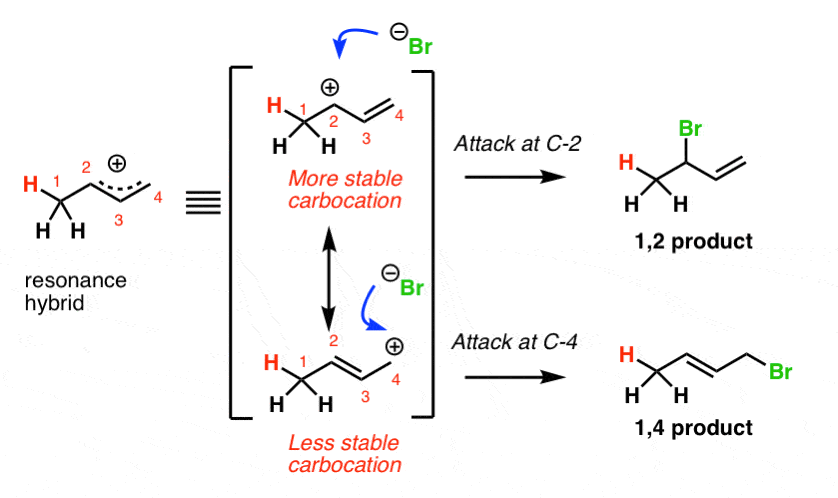
If the conversion of 1,2 product to 1,4 product is exothermic, how can it be favoured as the temperature increases? shouldn’t the equilibrium shift in the direction of the endothermic forward reaction by Le Chatelier’s principle?
I just want to thank you, thanks a lot !
You are welcome Khai, glad you’ve found it helpful.
Why does the more stable intermediate have a lower barrier to its transition state? Shouldn’t the opposite be true?
Hi,
Where can we find the solutions for the three examples toward the end?
Thanks!
J
Next post: https://www.masterorganicchemistry.com/2017/04/11/more-on-12-and-14-additions-to-dienes/
Difficult Concepts made so easy
Do you offer courses from scratch to proficient level
Do get back on my mail id
I am interested in a regular course that compels you to study
Am a tutor
Duration should be around 6 to 9 months
Is there ever a case where the 1,2 and 1,4 products are the same, regardless of temperature?
Sure. Cyclopentadiene. 1,2 addition of HBr and 1,4 addition of HBr gives you the same product: 3-bromocyclopentene